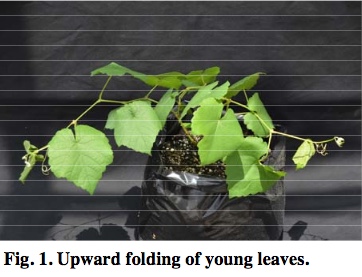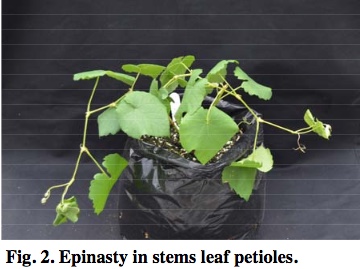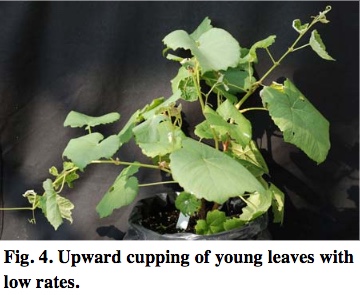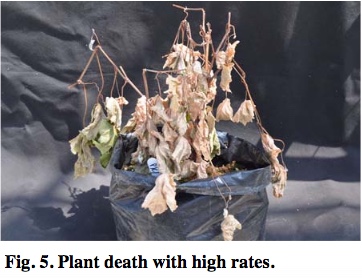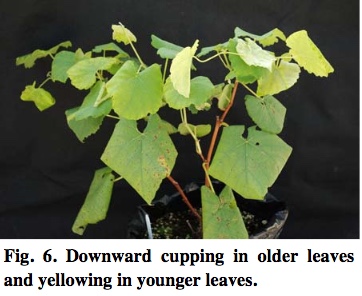Grape production is an increasingly important component of agriculture in Tennessee and many parts of the United States. Since many vineyards are located near pastures, hay fields or roads, off-target movement of pasture and right-of-way herbicides is becoming a major issue in grape production. While these herbicides are valuable tools for weed management, off-target damage to grape often results in expensive fines and/or lawsuits, reduced yields, delayed ripening, and poor fruit quality. Fortunately, preventive steps can be taken to avoid these problems.
(For more information, please refer to Extension publication Preventing Off-target Herbicide Problems in Vineyards, W297-A)
Agricultural chemicals, particularly pasture and right-of-way herbicides, have the potential to cause off-target damage to grapes. Although these herbicides control many troublesome weeds, off-target damage to tomatoes often results in expensive fines and/or lawsuits, lost productivity for growers, and even crop rejection. Several management practices can be adopted to avoid these problems.
- Herbicide Selection — Although highly effective on several broadleaf weeds in pastures and rights-of-way, the auxin or growth regulator herbicides can damage sensitive crops if not used properly. The characteristics of these herbicides determine which product to use in different situations.
- Volatile herbicides — change from a liquid to gas or vapor and move away from the target. Typically, dicamba and 2,4-D are more volatile than aminopyralid or picloram.
- Persistence of herbicides — The persistence of herbicides can affect future plans for a field. While dicamba and 2,4-D are highly active on grapes even in minute doses, these materials are relatively non-persistent in soil and in treated pasture grasses and hay. This is not the case with aminopyralid or picloram. Both of these herbicides can stay active in soil, pasture grass and hay for a year or longer
- Water Solubility — Picloram is more soluble than aminopyralid and therefore more likely to be moved off-site by runoff.
- Prevention of Drift — Several factors can contribute to herbicide drift to sensitive areas. physical and vapor, can occur. (Refer to the section “Spray Today?” in this website)
- Physical Drift — can occur when the herbicide is blown away from the target area on windy days and/or in runoff after a hard rain. It is important to monitor weather conditions several days prior to and after spraying to prevent physical drift.
- Vapor Drift — is the movement of spray vapor away from the target after the herbicide has been deposited on the target. It is mainly influenced by air temperature, but also by relative humidity (RH) and herbicide formulation.
- Field Selection — The location, characteristics and history of a field influence future management strategies. A proper risk assessment should be performed before spraying a pasture with some of these herbicides. Rains can wash certain herbicides downhill to sensitive areas.
- Sprayer Contamination — A common way for pasture herbicides to make it into vineyards is through sprayer contamination. Pasture herbicides are notoriously difficult to rinse from sprayers. Rinsing with water does not remove all herbicide residues from a sprayer and hoses
- Monitoring — Producers are encouraged to assess the performance of herbicides in pastures and hay fields. Tracking results will guide future decisions for weed control. It is important to keep a log of all applications with dates, products, field locations and weather conditions.
(For more information, please refer to Extension publication Diagnosing Suspected Off-target Herbicide Damage to Grape, W297-B)
Following proper stewardship recommendations can reduce the impact of off-target herbicides in vineyards (see UT Extension fact sheet W 297-A Preventing Off-target Herbicide Problems in Vineyards). However, these unfortunate events sometimes occur and diagnosing problems in the field is difficult. Many pasture herbicides mimic the plant hormone auxin, and symptoms can be quite similar.
Images and descriptions on this webpage are intended to highlight characteristic symptomology of each of these broadleaf herbicides on grape vines.
The following are descriptions of commonly observed symptoms resulting from exposureto synthetic auxin herbicides:
- Curling — Folding of edge of leaf margins.
- Epinasty — Twisting, bending and/or elongation of stems and leaf petioles.
- Blistering — Appearance of raised surfaces on leaf tissue.
- Chlorosis — Yellowing or whitening of leaves resulting from loss of chlorophyll.
- Necrosis — Browning of tissue resulting from cell death.
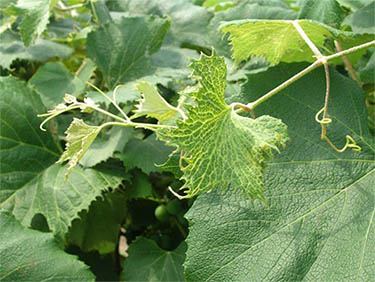
Common Name – Chemical Family – Trade Names
- aminocyclopyrachlor* – Pyrimidine-carboxylic acid – Not registered for use in pastures and hay fields
- aminopyralid – Pyridine-carboxylic acid – Milestone, ForeFront R&P, ForeFront HL, GrazonNext
- picloram – Pyridine-carboxylic acid – Tordon, Surmount, GrazonP+D
- 2,4-D** – Phenoxyacetic acid – Various names and mixtures
- Dicamba – Benzoic acid – Banvel, Clarity, Oracle, Rifle, Brash, Rangestar, Weedmaster
*Products containing aminocyclopyrachlor (MAT28) are registered for non-cropland use, but are not yet registered for use in pastures.
**Picloram, aminopyralid, and dicamba are often sprayed in combination with 2,4-D.
After exposure to picloram, grape vines exhibit symptoms relatively soon.
- Within four days after exposure, new leaves start folding upward (Figure 1).
- At one week, young leaves continue to curl and leaf petioles and stems begin to droop (Figure 2). Plants are generally not as upright as those exposed to aminocyclopyrachlor or aminopyralid.
- Higher rates of picloram exposure lead to severe drooping and early signs of necrosis within two weeks after exposure (Figure 3). Large leaves are often folded in half lengthwise and new growth has nearly ceased.
- At lower rates of picloram exposure, drooping is not as severe, and new leaves are cupped upward at two weeks (Figure 4).
- Within three weeks, higher rates of picloram exposure will result in plant death (Figure 5).
- Within three weeks, lower rates of exposure will result in yellowing of younger leaves and down-cupping of older leaves (Figure 6).
The following plant images were photographed over time to illustrate the development of symptoms after plants were exposed to picloram.
